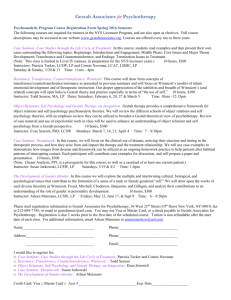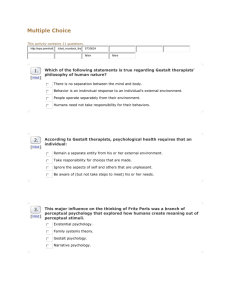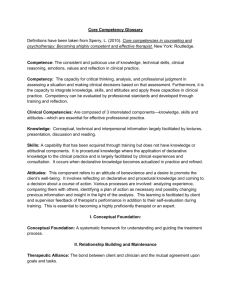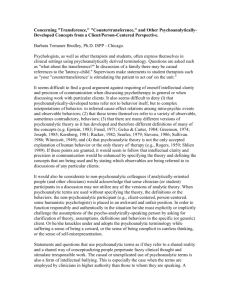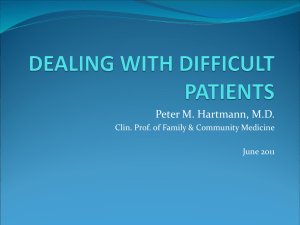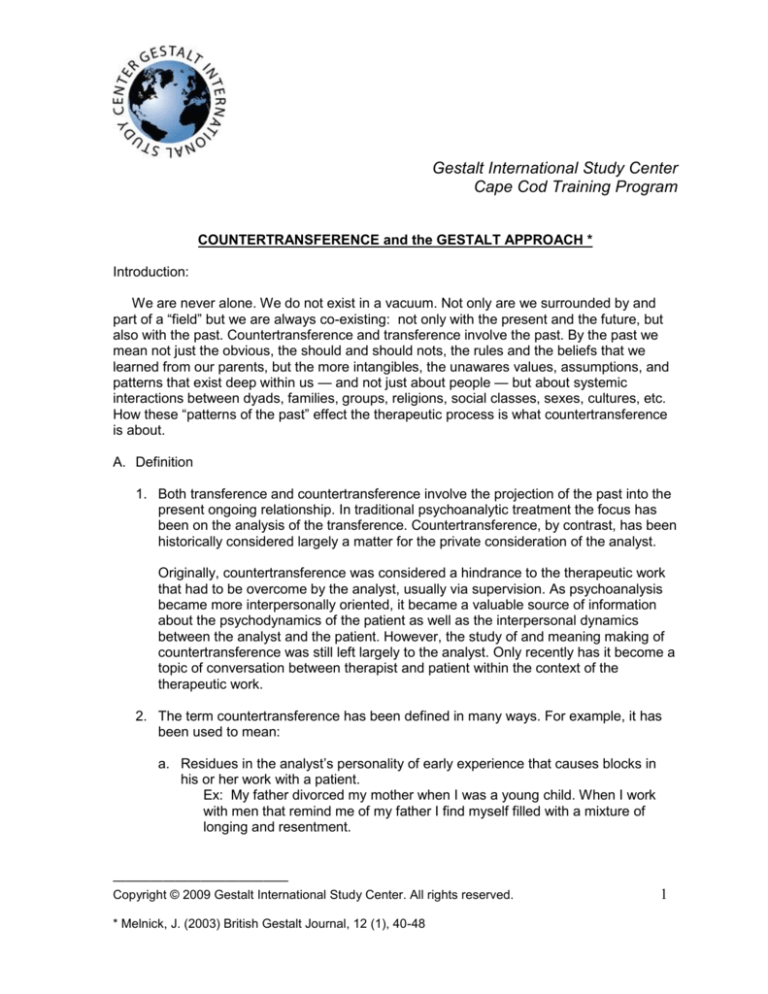
Gestalt International Study Center
Cape Cod Training Program
COUNTERTRANSFERENCE and the GESTALT APPROACH *
Introduction:
We are never alone. We do not exist in a vacuum. Not only are we surrounded by and
part of a “field” but we are always co-existing: not only with the present and the future, but
also with the past. Countertransference and transference involve the past. By the past we
mean not just the obvious, the should and should nots, the rules and the beliefs that we
learned from our parents, but the more intangibles, the unawares values, assumptions, and
patterns that exist deep within us — and not just about people — but about systemic
interactions between dyads, families, groups, religions, social classes, sexes, cultures, etc.
How these “patterns of the past” effect the therapeutic process is what countertransference
is about.
A. Definition
1. Both transference and countertransference involve the projection of the past into the
present ongoing relationship. In traditional psychoanalytic treatment the focus has
been on the analysis of the transference. Countertransference, by contrast, has been
historically considered largely a matter for the private consideration of the analyst.
Originally, countertransference was considered a hindrance to the therapeutic work
that had to be overcome by the analyst, usually via supervision. As psychoanalysis
became more interpersonally oriented, it became a valuable source of information
about the psychodynamics of the patient as well as the interpersonal dynamics
between the analyst and the patient. However, the study of and meaning making of
countertransference was still left largely to the analyst. Only recently has it become a
topic of conversation between therapist and patient within the context of the
therapeutic work.
2. The term countertransference has been defined in many ways. For example, it has
been used to mean:
a. Residues in the analyst’s personality of early experience that causes blocks in
his or her work with a patient.
Ex: My father divorced my mother when I was a young child. When I work
with men that remind me of my father I find myself filled with a mixture of
longing and resentment.
——————————————
Copyright © 2009 Gestalt International Study Center. All rights reserved.
* Melnick, J. (2003) British Gestalt Journal, 12 (1), 40-48
1
b. The aspects of the therapist’s experience that are responsive and complimentary
to the patient’s psychopathology.
Ex: I have an “anti-authoritarian streak..” So when my patient talks of ripping
off the system for his own gain I find myself silently cheering him on and
ignoring the moral, ethical and possibly sociopathic aspects of his action.
c. The entirety of the therapist’s experience and personality.
Ex: Who I am determines what I see and focus on. In essence I am always
helping to co-create the therapeutic hour. I am always implicitly or explicitly
helping to determine the content and process of the therapeutic hour.
d. Any aspect of the therapist’s experience or personality that the patient brings up
for consideration.
Ex: This definition is a more “old fashioned” one. It implies that I am not
being a blank screen if the patient is really noticing something about me —
the way I dress, for example.
3. Unlike psychoanalysis, the Gestalt therapist does not attempt to create a “blank
screen” to invoke or heighten transference, or to minimize countertransference, but
like the modern process oriented analyst views transference and
countertransference as “givens” that will be evoked in all situations.
4. In Gestalt therapy, we define countertransference as a primary contributor to “acontextual,” fixed, or pre-set ways of organizing the world of a therapist. When these
“systems of projections” exist outside of the therapist’s awareness and the
therapeutic themes and foci emerge, not just from the needs of the patient but out of
the unaware history and needs of the therapist. If these a-contextual organizations
and distortions are out of awareness, the therapist will have diminished presence
and capacity to respond to the client’s needs, wishes and wants.
Ex: If I am unconsciously frightened by interpersonal anger, than the
possibilities for my client expressing his legitimate (or illegitimate) anger
towards me and moving towards an increased awareness of the meaning of
it, or of our relationship, etc., is greatly diminished.
B. History of Transference – Countertransference
1. In The Psychopathy of Everyday Life, Freud remarked that “a young girl…aroused a
feeling of pleasure in me” which he had long thought was extinct. By an “apparently
clumsy movement,” he continues, “I suddenly found myself standing directly behind
her, and throwing my arms around her from behind; for a moment my hands met in
front of her waist (in front of her lap, in front of her genitals.)” 1901, p. 176.
2. At the beginning of psychoanalysis, not only Freud but Breuer and Jung committed
boundary violations with patents, and that terrified Freud. How disturbing this was
can be guessed from Freud’s remarks to Jung that a paper on countertransference
seemed to be “sorely needed” adding “of course we could not publish it, we should
have to circulate copies among ourselves.”
3. Therefore, at the beginning, countertransference was considered negative and it was
considered absolutely mandatory for the therapist to “surmount countertransference”
completely. Yet, paradoxically, the goal of treatment was first the heightening of, and
ultimately the overcoming of transference. Furthermore, transference was viewed as
——————————————
Copyright © 2009 Gestalt International Study Center. All rights reserved.
* Melnick, J. (2003) British Gestalt Journal, 12 (1), 40-48
2
the basic ingredient which motivated the patient. It is ironic that Freud did not see the
equal richness in countertransference, and chose to eliminate it from the therapeutic
process. He was unable to see that there is a hidden wisdom in countertransference
also. The elimination of it outside of treatment deprived the therapy of rich
possibilities.
4. In Gestalt therapy, a transference-countertransference is viewed as always present
in the interactions between individuals in the present moment. We hope to bring
these fixed gestalts into awareness and if appropriate, make it the subject of
dialogue.
5. Starting with Ferenzzi’s focus on the interactive dimensions of the relationships (and
the understanding of the therapist’s feelings as a tool for understanding the analytic
procedure) we began to look at the interaction between transference and
countertransference. The result is our modern view that countertransference as well
as transference are neither good nor bad but are consistently being evoked in the
therapeutic hour.
6. Another contributor was Bernice Kris in the 1950’s who believed that every hour had
its reality and a unique structure; a reality all its own and that countertransference
and transference were normal.
C. Relevance in working with individuals, couples and families.
Countertransference consists of:
1. Introjects: as indicated above, we are never alone in the moment. Almost always we
hear the voices of primary figures in our lives: parents, brothers, sisters, important
teachers, friends.
Ex: A man reminds you of your father. You grew up believing that one should
always respect your elders. This a-contextual pattern (introject) might in turn
cause him to respond to you as his son.
2. Sensory experience, sensations, smell, sounds, sight. Not just the content, but “the
sound of her voice reminds me of, the smell of the perfume…”
Ex: The color or your patient’s hair reminds you of your first love. You find
yourself gazing lovingly at her — feeling soft and tender towards her. She in
return might feel terribly confused as to why she is so special for no apparent
reason.
3. Energy — finding oneself being too much or too little interested in a client.
Ex: You find yourself bored by a client yet realize that this individual is
inherently no more boring or interesting than anyone else you see.
4. Patterns between you and the client.
Ex: You find yourself in a conversation with a client that reminds you of one
that your mother and you have had. You notice that you feel extra kindly
towards her. You notice that she responds to your extra kindness in a very
specific way.
5. When working with couples and families we not only pay attention to
countertransference with individuals but with the system, i.e. the couple and family.
——————————————
Copyright © 2009 Gestalt International Study Center. All rights reserved.
* Melnick, J. (2003) British Gestalt Journal, 12 (1), 40-48
3
Ex: You come from a quiet family and you and your significant other are a
quiet couple. You don’t spill your feelings and you love the peace and quiet of
your idyllic marriage. The couple you are seeing is yelling at each other. You
ask them to lower their voices (Why? How does that help their process?) You
try to fix them rather than raise their awareness.
D.
Countertransference not only deals with tangibles like our personal history, mannerisms,
and speech patterns, but more often deeply imbedded and less tangible variables
such as values, and interactional processes like nurturance, influence, and
vulnerability.
1. Values
Ex: You come from a family which is entrenched in the value of higher
education. A college age secretary and her husband start therapy with you.
You find yourself focusing on her and preaching to her that she can advance
herself by going to college (while ignoring her husband). Is this good for her?
Maybe yes - maybe no. What about him? Does your focus have anything to
do with your family’s values concerning education, male – female
relationships, as to who you address in the family system, etc?
2. Interactional Process: when working with couples and families we are most
concerned with countertransference with regards to transactional processes – what
goes on between the individuals in the intimate system. We deal primarily with three
main areas:
a. Support and nurturance. How was support expressed in your family or in your
parents’ relationship? Did individuals touch, encourage, feed each other? Was
the support function fluid or rigid, variable or assigned?
Ex: In your family or origin women were the ones who expressed soft
emotions. What will be stirred in you when you see a man cry?
b. Power and influence. How was the decision made to go for vacation, go to a
movie, buy a stereo, a car? Also, who decided? Who participated? Was it on the
basis of age, gender, competence and knowledge?
Ex: In your family your mother decided on and arranged all vacations. Does it
seem odd to you when you see a family where the mother just goes with
whatever is decided for her?
c. Vulnerability. How close do people get to each other — and in what ways? How
open and closed was your family, your parents? How did the family express love,
fight, make up? Was there a characterological style to this? Did it reside in one
individual? Could individuals cry, lean on one another?
Ex: If your parents touched each other easily and often, how are you when
you see a couple or family that rarely touch each other?
E. Hints regarding the existence of countertransference.
1. Besides an interest or lack of interest towards one part of the couple, also notice your
reactions to the content. Boredom, or the unawares withdrawal of energy is often a
sign.
2. Self-disclosure — if you find yourself self-disclosing content about yourself. Self
disclosure of self process is also suspect.
——————————————
Copyright © 2009 Gestalt International Study Center. All rights reserved.
* Melnick, J. (2003) British Gestalt Journal, 12 (1), 40-48
4
3. Telling of historical stories of self. At their best they are teaching tales that help
support the contact, or more usually the chewing over of the experience. At their
worst they draw energy away from the couple towards the therapist, and might be the
therapist’s unawares attempt to finish a situation.
4. Giving of advice — it can be positive. Often we are the experts and we know more
than the client system. However, it might instead be covering up our difficulty in living
with uncertainty, a sense of inadequacy in the moment, or countertransferential —
suggesting the client finish a situation that is unfinished for us.
——————————————
Copyright © 2009 Gestalt International Study Center. All rights reserved.
* Melnick, J. (2003) British Gestalt Journal, 12 (1), 40-48
5

